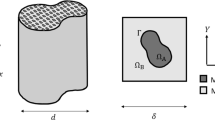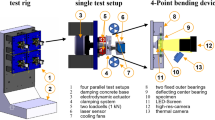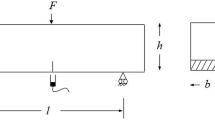Abstract
The plastic instability approach has been applied to the tensile behaviour of a continuous fibre composite. It is shown that the combination of two components with different strengths and degrees of work-hardening produces a new material with a new degree of work-hardening, which may be determined by the present analysis. Expressions for the elongation at rupture and the strength of a composite have been obtained and the results of the calculation are compared with some experimental data.
Similar content being viewed by others
Abbreviations
- V f :
-
volume fraction of fibres in composite
- ε′, ε″, ε :
-
true strain of fibre, matrix and composite
- s :
-
true stress
- σ′, σ″, σ :
-
nominal stress on fibre, matrix and composite
- σ *′,σ *″,σ * :
-
critical stress of fibre, matrix and composite (ultimate tensile strength)
- ε *′,ε *″:
-
critical strain of separate fibre and matrix
- ε * :
-
critical strain of composite
- Q :
-
external load
- A :
-
cross-sectional area
- A 0 :
-
initial value of area
References
A. Kelly andW. R. Tyson,J. Mech. Phys. Solids 13 (1965) 329.
E. G. Thomson, Ch. T. Yaug, andSh. Kobayashi, “Mechanics of Plastic Deformation in Metal Processing” (Macmillan, New York, 1965).
A. M. Markov et al, in the press (USSR).
H. R. Piehler,Trans. Met. Soc. AIME 233 (1965) 12.
Author information
Authors and Affiliations
Rights and permissions
About this article
Cite this article
Mileiko, S.T. The tensile strength and ductility of continuous fibre composites. J Mater Sci 4, 974–977 (1969). https://doi.org/10.1007/BF00555312
Received:
Issue Date:
DOI: https://doi.org/10.1007/BF00555312




